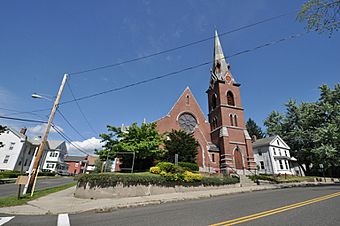Springfield Street Historic District facts for kids
Quick facts for kids |
|
|
Springfield Street Historic District
|
|

Christ's Community Church, on Springfield Street
|
|
| Location | Chicopee, Massachusetts |
|---|---|
| Area | 62 acres (25 ha) |
| Architect | Multiple |
| Architectural style | Mid 19th Century Revival, Late Victorian, Federal |
| NRHP reference No. | 90002217 |
| Added to NRHP | January 25, 1991 |
The Springfield Street Historic District is a special area in Chicopee, Massachusetts. It's a neighborhood with many old homes that are important to history. Most of these homes were built in the late 1800s. They include large, fancy houses for wealthy families. There are also homes for skilled workers from nearby factories. This historic area is found where Springfield Street and Fairview Avenue meet. It was added to the National Register of Historic Places in 1991. This means it is officially recognized for its historical importance.
Contents
Discovering the Springfield Street Historic District
Chicopee grew a lot in the 1800s. It became a big industrial town in the Pioneer Valley of Massachusetts. Many factories, especially textile mills, were built along the Chicopee River. These mills used the river's power to make cloth.
How Chicopee Grew
The main downtown area, called Cabotville, started developing around 1831. Investors from Boston created the Springfield Canal Company. This company helped provide water power for the new factories. Springfield Street was already a main road. It ran north to south, next to the Connecticut River. It stayed an important road as Chicopee grew.
Homes and History on Springfield Street
Before 1860, most of the buildings were north of South Street. The land to the south was mostly farms. People who worked as skilled laborers or managers in the mills often built their homes in the higher areas. These areas were a bit further from the factories.
After 1860, more homes started to appear south along Springfield Street. These new homes were often larger and more beautifully designed. They showed off the latest architectural styles of the time.
Exploring the District's Boundaries
The historic district is centered around the meeting point of Springfield Street, South Street, and Fairview Street. It stretches for several blocks in each direction.
Key Landmarks and Architecture
At the northeast edge of the district, you'll find the Maple Grove Cemetery. To the south, the boundary is Gaylord Street, just before the Elms College campus. Casino Avenue marks the western edge.
The older homes in the north and west parts of the district are simpler. They show styles like Greek Revival and Italianate. The newer homes to the east and south are grander. They feature styles like Queen Anne, Second Empire, and Colonial Revival. The district also has a few shops near its northern end. You can also find four churches within this historic area.



